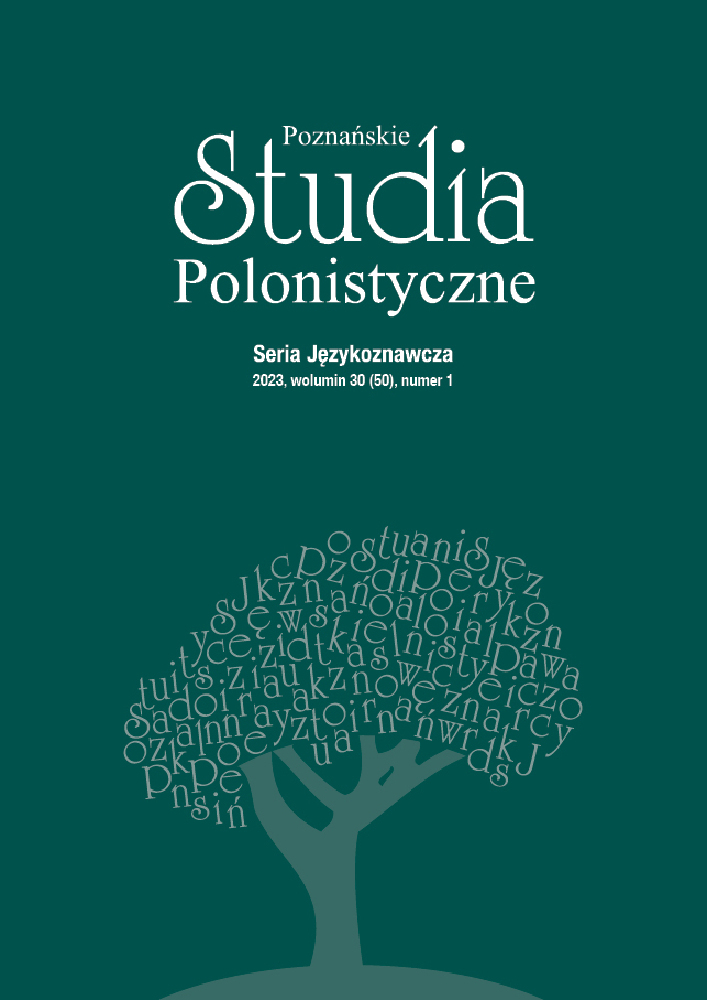Abstrakt
The aim of this article is to discuss the ways in which memory is perceived in genologically homogeneous texts. The subject of the research is the word pamięć (ang. “memory”) recalled by a witness of history or by a person interviewing him/her. The texts constituting the Oral History Archive of the Warsaw Rising Museum were the source of the analyses. The linguistic view of the phenomenon of memory made use of such concepts as the linguistic image of the world, the assumption of the genological and discursive specificity of each text, and collective memory. It was established that the use of the word memory by both the questioners and the narrators indicates its receptacle character, i.e. seeing memory as a place where elements of the past are stored, with the image of memory in the narrators’ account being dynamised. The second of the meanings is also actualised in the statements of the narrators, capturing memory as a specific capacity of the human mind, which the veterans subject to metareflection, assessing it as good, weak or incomplete. They recognise its malleable and changeable character. Witnesses also use the word memory in a third meaning, i.e. to recall the memory of past persons or events in order to honour them.
Bibliografia
AHM – Archiwum Historii Mówionej Muzeum Powstania Warszawskiego, https:// www.1944.pl/archiwum-historii-mowionej.html [access: 1 June 2022].
CLARIN-PL – Common Language Resources & Technology Infrastructure – https:// clarin-pl.eu/ [access: 1 June 2022].
SEJP – Boryś Wiesław (2005), Słownik etymologiczny języka polskiego, Kraków.
WSJP PAN – Żmigrodzki Piotr, red., Wielki słownik języka polskiego PAN, Kraków, http:// www.wsjp.pl [access: 1 June 2021].
Anusiewicz Janusz, Dąbrowska Anna, Fleischer Michael (2000), Językowy obraz świata i kultura. Projekt koncepcji badawczej, in: Językowy obraz świata i kultura, ed. Anna Dąbrowska, Janusz Anusiewicz, Wrocław, pp. 11–44.
Bartmiński Jerzy (2009), Językowe podstawy obrazu świata, Lublin.
Brzozowska Małgorzata (2009), Etymologia a konotacja słowa. Studia semantyczne, Lublin.
Chlebda Wojciech (2011), Szkice do językowego obrazu pamięci. Pamięć jako wartość, “Etnolingwistyka”, no. 23, pp. 83–98.
Chlebda Wojciech (2018), Pamięć a język. Zarys relacji, in: Pamięć w ujęciu lingwistycznym. Zagadnienia teoretyczne i metodyczne, ed. Waldemar Czachur, Warszawa, pp. 56–67. DOI: https://doi.org/10.31338/uw.9788323530077.pp.56-68
Czachur Waldemar (2018), Lingwistyka pamięci. Założenia, zakres badań i metody analizy, in: Pamięć w ujęciu lingwistycznym. Zagadnienia teoretyczne i metodyczne, ed. Waldemar Czachur, Warszawa, pp. 7–55. DOI: https://doi.org/10.31338/uw.9788323530077.pp.7-55
Ciesek-Ślizowska Bernadetta, Duda Beata, Sujkowska-Sobisz Katarzyna (2020), Władza nad dyskursem w narracji wspomnieniowej: przypadek Archiwum Historii Mówionej, “Tekst i Dyskurs”, no. 13, pp. 63–79. DOI: https://doi.org/10.7311/tid.13.2020.04
Duda Beata, Ficek Ewa (2020), Kolokacje pronominalne jako źródło tożsamościowych odniesień (na materiale relacji świadków powstania warszawskiego), “Poznańskie Studia Polonistyczne, Seria Językoznawcza”, no. 2, pp. 9–32. DOI: https://doi.org/10.14746/pspsj.2020.27.2.1
Kurkowska-Budzan Marta (2011), Informator, świadek historii, narrator – kilka wątków epistemologicznych i etycznych “oral history”, “Wrocławski Rocznik Historii Mówionej”, no. 1, pp. 9–34. DOI: https://doi.org/10.26774/wrhm.5
Machálek Tomáš (2020), KonText: Advanced and Flexible Corpus Query Interface, in: Proceedings of the 12th Conference on Language Resources and Evaluation (LREC 2020), Marseille, 11–16 May 2020, ed. Nicoletta Calzolari et al., Paris, pp. 7003–7008.
Pajdzińska Anna (2004), Niepamięć – córka niedbalstwa?, in: Studia nad polszczyzną współczesną i historyczną. Prace dedykowane Profesorowi Stanisławowi Bąbie w 65-lecie urodzin, ed. Jarosław Liberek, Poznań, pp. 229–236.
Pajdzińska Anna (2007), Pamięć jako wartość, in: Człowiek wobec wyzwań współczesności. Upadek wartości czy walka o wartość?, ed. Jan Mazur, Agata Małyska, Katarzyna Sobstyl, Lublin, pp. 253–261.
Przyklenk Joanna (2022), Kiedy obcy jest blisko. “Obcy” w relacjach świadków historii na materiale archiwum Muzeum Powstania Warszawskiego, in: Bliskie otoczenie człowieka. Leksyka, teksty, dyskursy, ed. Magdalena Hawrysz, Magdalena Jurewicz-Nowak, Irmina Kotlarska, Zielona Góra, pp. 97–111.
Szpociński Andrzej (2006), Formy przeszłości a komunikacja społeczna, w: Przeszłość jako przedmiot przekazu, ed. Andrzej Szpociński, Piotr Tadeusz Kwiatkowski, Warszawa, pp. 7–67.
Wierzbicka Anna (2007), Is “Remember” a Universal Human Concept? “Memory” and Culture, in: The Language of Memory in a Crosslinguistic Perspective, ed. Mengistu Amberber, Amsterdam–Philadelphia, pp. 13–39. DOI: https://doi.org/10.1075/hcp.21.04wie
Witosz Bożena (2003), Schematy, wzorce tekstowe, gatunki mowy… O kategoryzacji, kategoriach wypowiedzi językowych i ich modelowaniu, “Przestrzenie Teorii”, no. 2, pp. 89–102. DOI: https://doi.org/10.14746/pt.2003.2.6
Licencja
Prawa autorskie (c) 2023 Joanna Przyklenk

Utwór dostępny jest na licencji Creative Commons Uznanie autorstwa – Bez utworów zależnych 4.0 Międzynarodowe.
Autorzy
Autor oświadcza, że przysługują mu osobiste i majątkowe prawa autorskie do utworu publikowanego w czasopiśmie „Poznańskie Studia Polonistyczne. Seria Językoznawcza”, oraz że nie są one ograniczone w zakresie objętym umową autorską, oraz że utwór jest dziełem oryginalnym i nie narusza majątkowych lub osobistych praw autorskich innych osób, ani innych praw osób trzecich, w tym dóbr osobistych.
Autor(zy) zachowują pełne prawa do dalszego, swobodnego rozporządzania utworem, udzielając Uniwersytetowi im. Adama Mickiewicza w Poznaniu niewyłącznej i nieodpłatnej licencji CC BY-ND 4.0 Międzynarodowe na korzystanie z utworu bez ograniczeń terytorialnych przez czas nieokreślony na określonych umową autorską polach eksploatacji.
Użytkownicy
Zainteresowani użytkownicy internetu uprawnieni są do korzystania z utworów opublikowanych od 2016 roku w „Poznańskich Studiach Polonistycznych. Serii Językoznawczej” pod następującymi warunkami:
- uznanie autorstwa – obowiązek podania wraz z rozpowszechnionym utworem informacji, o autorstwie, tytule, źródle (odnośniki do oryginalnego utworu, DOI) oraz samej licencji;
- bez tworzenia utworów zależnych – utwór musi być zachowany w oryginalnej postaci, nie można bez zgody twórcy rozpowszechniać np. tłumaczeń, opracowań.
Do wszystkich tekstów opublikowanych przed 2016 r. prawa autorskie są zastrzeżone.
Inne
Uniwersytet im. Adama Mickiewicza w Poznaniu zachowuje prawo do czasopisma jako całości (układ, forma graficzna, tytuł, projekt okładki, logo itp.).

